HIGHLIGHTS OF THE PHILIPPINE EXPORT AND IMPORT STATISTICS
APRIL 2019 (Preliminary)
|
|
Exports |
Imports |
||
|
April 2019 p |
April 2018 r |
April 2019 p |
April 2018 r |
|
|
TOTAL |
|
|
|
|
|
FOB Value (in Million US Dollars) |
5,506.24 |
5,481.27 |
9,005.27 |
9,180.81 |
|
Year-on-Year Growth (Percent) |
0.4 |
-1.9 |
-1.9 |
28.6 |
|
Electronic Products |
|
|
|
|
|
FOB Value (in Million US Dollars) |
3,121.00 |
3,030.92 |
2,358.20 |
2,312.19 |
|
Year-on-Year Growth (Percent) |
3.0 |
7.5 |
2.0 |
18.9 |
|
Top 10 Philippine Exports and Imports to and from All Countries: April 2019 p
(Year-on-Year Growth in Percent)
|
|||
|---|---|---|---|
|
Gainers |
Losers |
||
|
Exports
|
|||
|
Bananas (Fresh)
|
76.7 |
Metal Components
|
-27.2 |
|
Gold
|
36.1 |
Chemicals
|
-12.9 |
|
Machinery and Transport Equipment
|
28.5 |
Other Mineral Products
|
-11.9 |
|
Coconut Oil
|
18.1 |
|
|
|
Ignition Wiring Set and Other Wiring Sets Used in Vehicles, Aircrafts and Ship
|
14.5 |
|
|
|
Other Manufactured Goods
|
4.0 | ||
|
Electronic Products
|
3.0 | ||
|
Imports
|
|||
|
Mineral Fuels, Lubricants and Related Materials
|
36.5 |
Transport Equipment
|
-27.7 |
|
Cereals and Cereal Preparations
|
34.7 |
Plastics in Primary and Non-primary Forms
|
-14.2 |
|
Miscellaneous Manufactured Articles
|
11.0 |
Iron and Steel
|
-14.2 |
|
Other Food and Live Animals
|
3.2 |
Industrial Machinery and Equipment
|
-10.6 |
|
Electronic Products
|
2.0 |
Telecommunication Equipment and Electrical Machinery
|
-1.0 |
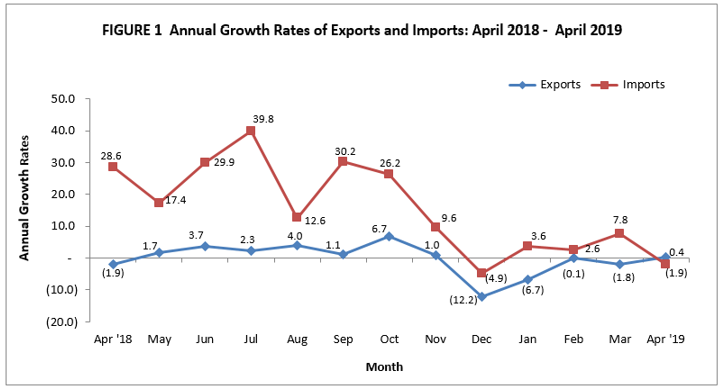
The country’s total external trade in goods in April 2019 amounted to $14.51 billion, reflecting a decrease of 1.0 percent from the $14.66 billion external trade in the same month of the previous year. Of the total external trade, $5.51 billion or 37.9 percent were exported goods and $9.01 billion or 62.1 percent were imported goods.
The country’s balance of trade in goods (BoT-G) went down to $3.50 billion deficit in April 2019, from $3.70 billion deficit in April 2018. (Tables 1, 2 and 3)
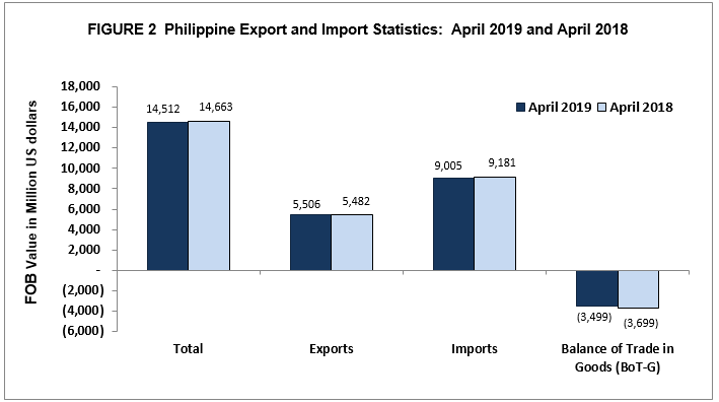
1. Exports increase by 0.4 percent while imports decrease by 1.9 percent
The country’s total export sales in April 2019 was $5.51 billion, indicating a slight increase of 0.4 percent, from the $5.48 billion total export sales in April 2018. This was due to the increases in export sales of the seven of the top 10 major export commodities, namely, fresh bananas (76.7%); gold (36.1%); machinery and transport equipment (28.5%); coconut oil (18.1%); ignition wiring set and other wiring sets used in vehicles, aircrafts and ships (14.5%); other manufactured goods (4.0%) and electronic products (3.0%).
By commodity group, export of electronic products continued to be the country’s top export with total earnings of $3.12 billion. This amount, which accounted for 56.7 percent of the total exports’ revenue in April 2019, went up by 3.0 percent from the $3.03 billion export receipt in April 2018. Components/devices (semiconductors) accounted for the biggest share of 41.2 percent among the electronic products. It posted an increment of 1.2 percent, from $2.24 billion in April 2018 to $2.27 billion in April 2019.
On the other hand, total imported goods in April 2019 decreased by 1.9 percent, from $9.18 billion in April 2018 to $9.01 billion in April 2019. The decrement was due to the declines in five of the top 10 major import commodities. These were transport equipment (-27.7%); plastic in primary and non-primary form (-14.2%); iron and steel (-14.2%); industrial machinery and equipment (-10.6%) and telecommunication equipment and electrical machinery (-1.0%).
Among the imported commodity group, import bills of electronic products, valued at $2.36 billion, accounted for the highest share of 26.2 percent to the total imports. Import of this commodity group rose by 2.0 percent, from $2.31 billion in April 2018. Among the electronic products, components/devices (semiconductors) accounted for the biggest contribution of 17.2 percent. It fell by 2.0 percent, from $1.58 billion in April 2018 to $1.55 billion in April 2019. (Table 3)
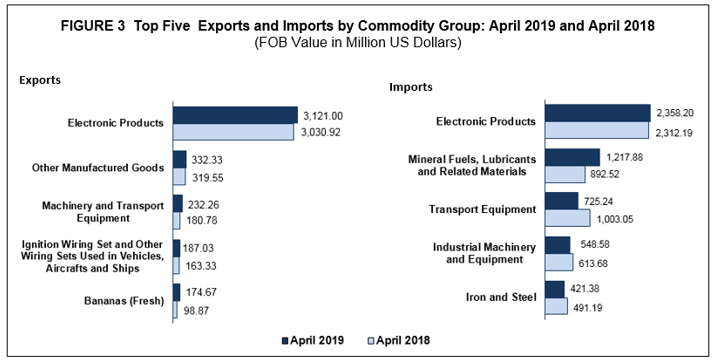
2. Exports of manufactured goods increase by 2.0 percent while imports of raw materials and intermediate goods decrease by 16.3 percent
By major type of goods, exports of manufactured goods, representing 84.1 percent of the total exports, were valued at $4.63 billion in April 2019. It went up by 2.0 percent from the $4.54 billion export value in April 2018. This was followed by exports of total agro-based products and mineral products amounting to $444.68 million and $316.25 million, respectively. (Table 4)
On the other hand, imports of raw materials and intermediate goods posted the largest contribution of 36.8 percent to the total import value. It contracted by 16.3 percent, from $3.96 billion in April 2018 to $3.31 billion in April 2019. Semi-processed raw materials contributed $3.08 billion or 34.2 percent to the total imports.
Imports of capital goods ranked second, sharing 31.4 percent and import value of $2.83 billion. Consumer goods placed third with a share of 17.2 percent and value worth $1.55 billion. (Table 5)
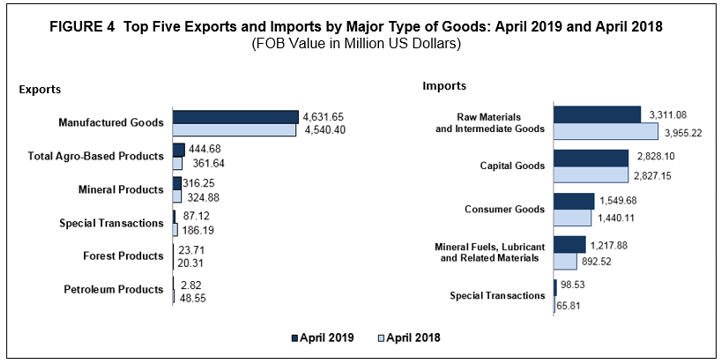
3. Exports to USA account for 16.5 percent while imports from People’s Republic of China account for 23.9 percent
By major trading partners, exports to the United States of America (USA) posted the highest export value of $906.98 million or a share of 16.5 percent to the total exports in April 2019. Exports to this country expanded by 10.6 percent, from $819.91 million in April 2018. Other major export trading partners were People’s Republic of China, $804.39 million; Japan, $780.99 million; Hong Kong, $704.82 million; and Singapore, $275.33 million. (Table 6)
People’s Republic of China was the country’s biggest supplier of imported goods with 23.9 percent share to total imports in April 2019. Import payments from this country reached $2.15 billion, from $1.83 billion in April 2018. Other major import trading partners were Japan, $827.73 million; Republic of Korea, $710.41 million; United States of America, $663.95 million; and Singapore, $555.89 million. (Table 7)
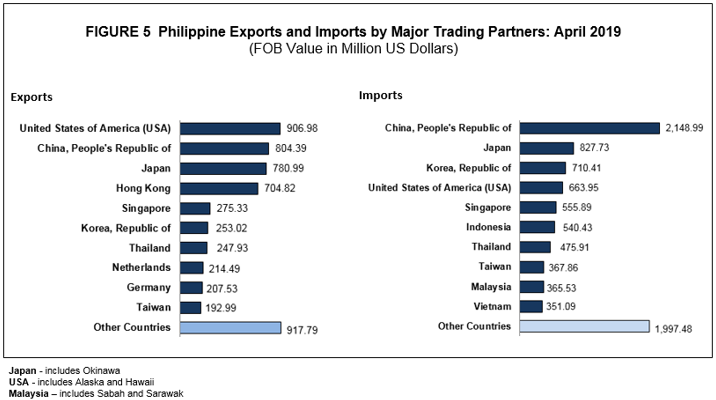
4. Exports to countries in East Asia comprise 49.7 percent while imports reach 48.3 percent
By economic bloc, majority of the country’s merchandise exports in April 2019, which comprised 49.7 percent of total exports or $2.74 billion, went to countries in East Asia. This amount went up by 1.8 percent, from $2.69 billion in April 2018. Similarly, East Asia was the biggest supplier of the country’s imports in April 2019, amounting to $4.35 billion or 48.3 percent of the total imports. This amount decreased by 3.8 percent, from $4.52 billion in April 2018.
Total exports to the ASEAN member countries was valued at $855.89 million or with a share of 15.5 percent to total export value. It went down by 5.1 percent from the export value of $901.98 million in April 2018. Commodities imported from ASEAN member countries reached $2.30 billion. It contributed 25.5 percent to total import and grew by 0.6 percent from the recorded import value of $2.28 billion in April 2018.
Exports to the United States of America (USA) worth $906.98 million had a share of 16.5 percent. It increased by 10.6 percent from the recorded value of $819.91 million in April 2018. However, imports from USA with an amount of $663.95 million, went down by 3.0 percent from the April 2018 value of $684.38 million.
Goods exported to European Union (EU) member countries registered a value of $666.50 million or a share of 12.1 percent. It decreased by 9.0 percent from its value of $732.41 million in April 2018. Moreover, imports from the European Union (EU) recorded a value of $667.11 million or a share of 7.4 percent. It decreased by 1.7 percent from the April 2018 value of $678.42 million. (Table 10)
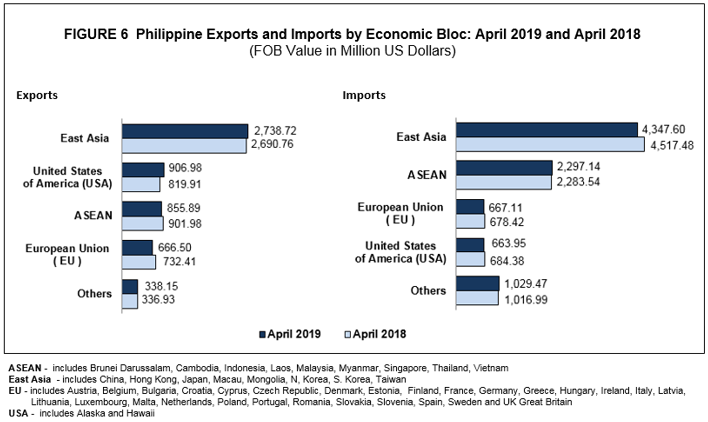
Export and Import trade statistics are compiled by the Philippine Statistics Authority (PSA) from copies of export and import documents submitted to the Bureau of Customs (BOC) by exporters and importers or their authorized representatives as required by law. PSA collects copies of these accomplished forms. These are the following documents:
- Export Declaration (ED – DTI form)
- Import Entry & Internal Revenue Declaration (BOC IEIRD Form 236)
- Informal Import Declaration and Entry (BOC Form 177)
- Single Administrative Documents (SAD)
The output of the Automated Export Documentation System (AEDS) of the BOC is being utilized to generate export statistics. AEDS is a paperless transaction in lieu of the manual filling-up of export documents.
Moreover, an electronic copy of the IEIRD or SAD, is utilized to capture the monthly import figures. SAD-IEIRD is an on-line submission of import documents either by brokers or companies. These are transactions that pass through the Automated Cargo Operating System (ACOS), now called the e2m (electronic to mobile) customs system, a system implemented through the BOC e-Customs Project.
All documents (hard copies and e-files) received before the cut-off date which is every 25th day of the month, are compiled, processed and generated in monthly statistical tables for the preparation of Press Release. All documents received after the cut-off date, however, are processed and included in the generation of the revised monthly statistical tables.
The digitized copies of all documents are provided by BOC and PEZA to PSA on a monthly basis through email.
Processing includes coding, editing, review and validation. Revised statistical tables are made available 10 to 15 working days after the press release date.
The Press Release for a reference month is due 40 days after every month. However, if the 10th day falls on a Saturday, release will be on Friday but if it falls on a Sunday or Monday the release will be on Tuesday. If the release date falls on a holiday, the date of release is moved accordingly.
The 2015 Philippine Standard Commodity Classification (PSCC) is used to classify the commodities at the most detailed 10-digit code level for statistical purposes.
International merchandise trade statistics are available at Philippine Statistics Authority, Economic Sector Statistics Service, Trade Statistics Division (Telephone Number: 376-19-75).
